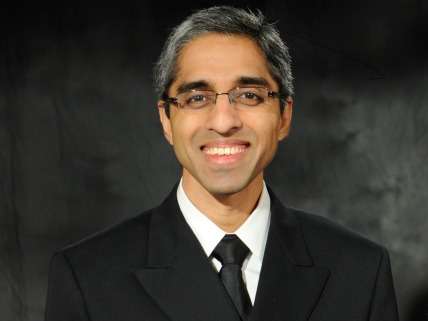Fixating on Adolescent Vaping Could Be Deadly for Adult Smokers
A new critique of the surgeon general's report on e-cigarettes puts underage use in perspective.

The first surgeon general's report on e-cigarettes, published last December, could have highlighted the enormous harm-reducing potential of products that simulate smoking but do not contain tobacco or burn anything. Instead Surgeon General Vivek Murthy sounded the alarm about adolescent vaping, which he called "a major public health concern." A critique of Murthy's report, published online yesterday by Harm Reduction Journal, shows how dangerously misguided his concerns were.
"The majority of e-cigarette use among US youth is infrequent and experimental, and minimal among never-smoking youth," note Italian internist and tobacco researcher Riccardo Polosa and his co-authors. "Additionally, the majority of the very small proportion of US youth who do use an e-cigarette frequently are actually using e-cigarettes that do not contain nicotine." Polosa et al. also point out that "the increasing prevalence of e-cigarette use between 2010 and 2015 has coincided with the sharpest declines in the smoking rate among US youth and young adults on record."
Murthy, who was removed from his post in April but has not been permanently replaced yet, focused on the share of teenagers who report using an e-cigarette in the previous month, which rose "an astounding 900 percent" (from 1.5 percent to 16 percent) between 2011 and 2015, as measured by the National Youth Tobacco Survey (NYTS). Digging more deeply into the survey data, Polosa et al. show that relatively few teenagers vape frequently and almost all of those who do are current or former smokers. In the 2015 NYTS, for example, just 0.6 percent of middle school students and 2.5 percent of high school students reported vaping on 20 or more days in the previous month. According to the 2014 Monitoring the Future Study (MTF), less than 1 percent of teenagers who vape that often are never-smokers.
The MTF data also indicate that most adolescents who vape use nicotine-free e-liquids, which makes Murthy's fear that they will get hooked on the drug and later graduate to smoking seem even more fanciful. On the face of it, nothing like that seems to be happening. As Polosa and his colleagues point out, "the increasing rate of ever-use of e-cigarettes among US youth has coincided with the sharpest declines in youth smoking rates in many decades." That is true for young adults as well as teenagers.
The coincidence of these opposing trends does not necessarily mean that e-cigarettes have hastened the decline in smoking. But it is a plausible possibility that should not be overlooked by public health officials who want to reduce smoking-related morbidity and mortality, since e-cigarettes are far less hazardous than the conventional kind. Even in the rare instances where teenagers who have never tried tobacco take up vaping, they are far better off in terms of health risks if they otherwise would be smoking. As Polosa et al. note, "e-cigarettes may have the potential to reduce the likelihood of smoking initiation among youth who may be especially at risk for initiating smoking in the absence of e-cigarettes."
The studies that Murthy cited as evidence that vaping leads to smoking show only that teenagers who try the former are more likely to try the latter. "There was no evidence that adolescents were regular e-cigarette users at baseline," Polosa et al. note, "and no evidence that they were smoking cigarettes regularly at follow-up." Even if some teenagers go through a vaping phase before becoming regular smokers, that does not necessarily mean the experience of vaping makes them more inclined to smoke. An attraction to both forms of nicotine consumption could be a function of personality and circumstance.
If e-cigarettes are a gateway to the real thing, that gateway is so tiny that its impact cannot be seen in smoking trends. "At the very least," Polosa et al. observe, "available data appear reassuring that e-cigarettes are not decelerating, let alone reversing, declining rates of youth smoking."
Although Murthy conceded that vaping is less hazardous than smoking, he obscured the magnitude of the difference, partly by hyping the potential hazards of e-cigarettes (such as formaldehyde produced by unrealistic overheating). You would never guess from the surgeon general's report that "the risk posed by long-term inhalation of aerosol produced by properly manufactured e-cigarettes is unlikely to exceed 5% of the risk associated with long-term inhalation of cigarette smoke," as Polosa and his co-authors summarize the evidence.
In light of that huge difference in risk, the danger of fixating on adolescent vaping is clear. Policies aimed at preventing teenagers from using e-cigarettes may also deter smokers from switching, with potentially deadly results.
Murthy, for example, suggested that restrictions on e-liquid flavors are worth considering as a way of making e-cigarettes less appealing to teenagers. But as Polosa and his colleagues note, "flavors appear to play an important role in perceived satisfaction and self-reported effectiveness of e-cigarettes among adults who have used e-cigarettes to stop smoking." Surveys find that "adult smokers appear to prefer tobacco flavor when they start using e-cigarette, but as e-cigarette use develops, preferences appear to dimish for tobacco flavor and grow for sweet and fruit flavors." The availability of those varieties may "help the e-cigarette user to sustain abstinence from smoking, since such flavors should be less likely than tobacco flavor to cue smoking as a conditioned response."
Details like that don't matter to officials who are so focused on the minor problem of adolescent experimentation with e-cigarettes that they overlook the lifesaving potential of these products. But they matter to anyone who believes smokers should have the option of consuming nicotine in a way that is much less likely to kill them.

Show Comments (5)